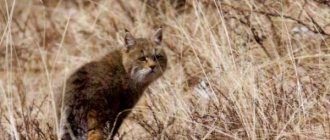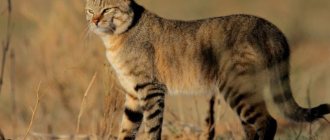Description
The Margay is a beautiful, spotted, small cat, slightly larger than a large domestic cat. The coat color varies from reddish-yellow to gray-brown. The animal's body has dark spots and rosettes with a brown center. The head, neck and throat are covered with black lines, and the backs of the ears are black with a white spot in the center. The belly is whitish, and the long and bushy tail is marked with 10-12 dark rings. A cat's fur is relatively thick and soft. The species has many individual variations in body patterns. Males and females are similar in size and appearance.
The average body length, including the head, ranges from 463 to 790 mm, the tail length is 331 – 510 mm. Margay weighs from 2.6 to 3.9 kg.
Margay cats are often confused with their close relatives - ocelots and oncillas. The article “Tiger cats: ocelot, margay, oncilla, and their comparative characteristics” highlights the main differences between these 3 species.
The following subspecies are currently recognized:
- L. wiedii wiedii, eastern and central Brazil, Paraguay, Uruguay, northern Argentina;
- L. wiedii amazonicus, western Brazil, Peru, Colombia and Venezuela;
- L. wiedii boliviae, Bolivia;
- L. wiedii cooperi, northern Mexico;
- L. wiedii glauculus, central Mexico;
- L. wiedii nicaraguae, Honduras, Nicaragua, Costa Rica;
- L. wiedii oaxacensis, southern Mexico;
- L. wiedii pirrensis, Panama, Colombia, Ecuador, Peru;
- L. wiedii salvinius, Chiapas, Guatemala, El Salvador;
- L. wiedii yucatanicus, Yucatan.
Who is the prairie cat?
The steppe cat (Felis Silvestris Lybica) is a wild cat that is a subspecies of the European forest cat. The history of the origin of the subspecies is interesting. 170,000 years ago the subspecies separated from the main species. And 10,000 years ago, these cats were domesticated by the inhabitants of the Middle East - this is evidenced by the images of steppe cats on ancient Egyptian frescoes. They became the progenitors of all modern breeds.
Steppe cats are the ancestors of all domestic purrs
The subspecies Felis Silvestris Lybica belongs to the cat family (Felidae), subfamily of small cats (Felinae), genus of cats (Felis), species of forest cats (Felis Silvestris). Previously, the Lybica group (steppe cats) was divided into two subgroups, each of which had several more representatives:
- subgroup steppe cats (ornata-caudata): Felis silvestris caudata (discovered in 1874);
- Felis silvestris gordoni (1968);
- Felis silvestris iraki (1921);
- Felis silvestris nesterovi (1916);
- Felis silvestris ornata (1832);
- Felis silvestris tristrami (1944).
- Felis silvestris cafra (1822);
However, recently zoologists have decided to simplify the classification. Now all steppe cats are divided into African (Fs lybica), Asian (Fs ornata) and South African (Fs cafra).
Category in the Red Book - 4: Very rare, small in number, poorly studied species, the population dynamics of which are unknown. Due to loss of habitat, poaching and close proximity to people, steppe cats are in danger of extinction.
The steppe cat is a rare species that is in danger of extinction
Habitat
Long-tailed cats are limited to forest habitats, and are closely associated with dense lowland forests below 1500 meters above sea level. They have been found in tropical moist evergreen and deciduous forests, montane and cloud forests, wet, swampy savannas, and sometimes in coffee and cocoa plantations with large trees. Mexico is the northernmost limit of their distribution, which ranges down through Central and South America to northern Argentina.
Margay cats do not tolerate altered habitats, and refuse to cross open areas without vegetation. They avoid converted landscapes except for dense plantations of coffee, cocoa, eucalyptus and pine. Thanks to a study conducted in northern Argentina, lower densities of margay cats were found in parks and other protected areas, possibly due to high ocelot numbers.
Natural enemies of Margai
Photo: Margay cat
Almost nothing is known about the enemies of margays found in the wild natural environment. This is due to the fact that these cats lead a very secretive and solitary life, being in dense impenetrable jungles and high on tree branches. Here we can only assume that larger predatory animals are capable of attacking these amazing cats. There is no specific data on this matter.
It is known that, sensing danger, the margay immediately jumps onto a tree, can hide in the dense crown or take a defensive stance if a fight is inevitable. Most often, inexperienced young animals and very small defenseless kittens suffer, which are most vulnerable at those moments when their mother goes hunting. There is disappointing data that only 50 percent of babies survive to one year.
Scientists have not been able to find out who the specific enemy of the margay is in wild natural conditions, but there is one insidious ill-wisher who has led to the fact that there are very few of these cats left, the name of this malicious enemy is man. It’s sad to realize, but people are the main exterminators of these beautiful and graceful animals, who suffer because of their valuable and attractive skin.
Reproduction
Long-tailed cats are solitary animals, with the exception of females with kittens. After a gestation period of approximately 76 – 85 days, one kitten is born, (rarely two), once a year. Unlike other types of wild cats, margas have only one pair of mammary glands, and estrus can occur spontaneously. Their birth weight is 84-170 grams and their eyes open at around two weeks of age. The fur of juveniles is darker than that of adults and evenly covered with dark spots, and their paws are dark gray. Weaning from mother's milk occurs at about two months of age, and sexual maturity occurs at two years.
Population and species status
Photo: What margay looks like
Currently, the population of margays has greatly decreased. It's sad to realize this, but felines are facing extinction. This is a deplorable situation throughout almost the entire habitat of this unusual cat. This is due to barbaric human actions aimed only at pleasing people.
First of all, the extermination of margays due to their expensive and beautiful fur greatly reduced the cat population. For many years, cats were relentlessly hunted in order to obtain their silky patterned coat. There is evidence that in the seventies of the last century, about thirty thousand cat skins were sold on the international market annually, which led to a strong and sharp decline in the margay population. Now the Washington Convention is in force, which monitors compliance with the ban on hunting and all trade in margay fur. Despite the strict ban, cases of poaching still occur, which greatly worries environmental organizations.
Man has reduced the population of margays, not only by hunting them, but also by carrying out other economic activities. Animals are greatly threatened by human intervention in their natural habitats, deforestation, degradation of permanent habitats and environmental pollution in general. Margai need special protective measures in order not to completely disappear from our planet.
Behavior
Long-tailed cats primarily live in trees, but they hunt and roam on land. They are agile and acrobatic climbers, thanks to their wide feet, flexible toes and large claws, while their long tail provides balance. Additionally, the hind legs can rotate inward 180°, allowing cats to grip a tree trunk, making them the only cat capable of climbing upside down in vertical trees. Their exceptionally long, heavy tails help balance them when moving from tree to tree. Also, long-tailed cats are able to hang on branches using their hind legs, and use their front legs to handle some object. Typically, they are active at night and rest in trees during the day.
What does margay eat?
Photo: Margay cat
Since the long-tailed cat is a predator, its menu consists mainly of dishes of animal origin. The dimensions of margays are small, so their victims are most often small mammals that also live in tree branches.
So, the Margi cat is not averse to a snack:
- rats;
- proteins;
- possums;
- small birds;
- bird eggs and defenseless chicks.
Yes, a wild cat sometimes commits robbery, destroying bird nests, from where it steals eggs and small chicks. If there is nothing tastier, then the margay will eat a lizard, a frog, and even various large insects. Feline predators can also attack monkeys, porcupines, and sloths. Zoological scientists have found that margays need about half a kilogram of food every day for a normal and active life.
For the most part, mustaches hunt all night long, returning to their lair only early in the morning. The hunting process can take place not only in the tree crown, but also on the hard earth's surface. Margai love to make ambushes, attack suddenly and pursue their fleeing dinner.
Interesting fact: Surprisingly, the cat’s menu also includes plant food, which consists of various fruits, berries, grass and young shoots. Of course, in percentage terms it is significantly inferior to animal food, but it is still present in the diet.
Threats
The population status of long-tailed cats is difficult to determine due to poor publicity. Apparently the cat population has dropped significantly. Several decades ago, this species was one of the most heavily exploited Latin American cats in the international fur trade, especially after concerns were raised about the high level of exploitation of ocelots. The small size of Margay cats means that at least 15 pelts must be used to make one coat, and approximately 14,000 of the species were traded annually between 1976 and 1984. Even though long-tailed cats have less valuable fur than ocelots, they can get caught in ocelot traps. The introduction of legal protections against illegal hunting is an ongoing issue in some cat areas. The main threat to margi cats is considered to be habitat destruction as a result of deforestation, land use for agriculture, and road construction. The arboreal lifestyle, combined with its naturally low numbers and low reproductive rate, makes the margay cat particularly vulnerable.
Life in captivity
Despite its cute appearance, the margay is still a predator, so it is difficult for him to adapt to home life. If there is a small animal in the house, then the margai will definitely feast on it. Even a dog can suffer from the teeth and claws of this cat. Therefore, representatives of this species are most often found in zoos. This animal can also be legally purchased from a specialized nursery. Its price is about $20 thousand. Fortunately, margays reproduce well in captivity.
If you take a margay as a kitten and raise it correctly, then it will not attack people as an adult.
The necessary conditions
The place where the margay lives must be surrounded by a fence. If you choose a private home, then all windows and doors should be covered with bars. Such precautions are due to the fact that the animal may leave home and not return, which is very dangerous for its health, especially in cold regions. In places with a relatively warm and humid climate, the animal can live in an enclosure covered with high mesh. It should have a miniature house where the cat can sleep at night. If it is not there, then you will have to provide the predator with an overnight stay in the house.
In regions with a warm and humid climate, margay can live in an enclosure
Trees should be located in the blinking enclosure. It would be good if there were green spaces nearby, next to which the animal would feel as if it were in its natural environment.
The cat's diet should include meat and small bones:
- Chicken;
- beef;
- feed mice.
Offal can also be added to food. It is recommended to add vitamins to them, which the veterinarian will tell you about.
With the right actions of the owner, the long-tailed cat will very soon be tamed. However, she still won’t be able to sit on them for long.
A friend told me that while she was traveling abroad, she stopped in Peru. Many residents there keep long-tailed cats at home. But it’s quite difficult to call them tamed, since every now and then they try to bite their owners - that’s just their “way of communication.” Of course, they are affectionate, but only as much as their wild nature allows. These animals are quite beautiful, as my friend was able to see with her own eyes. But her pussy still didn’t let her stroke herself - she tried to bite. She feeds exclusively on raw meat; sometimes she definitely needs to eat greens (grass or leaves).











